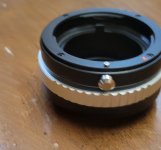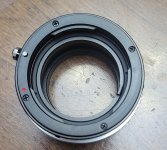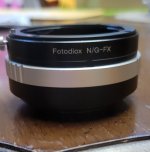What I find amazing is back in my film days, there was no such thing as a 'conversion factor' to compare lenses between 135, 120 and 4x5 formats. I never heard of a number to multiply (or divide by) when changing from 35mm to 6x4.5 format, or to 6x7 format, or to 4x5 format. I never had to 'convert' the 80mm lens of my Mamiya 645 to 'the equivelant of __mm on my 35mm camera". Nor convert the 150mm on my 4x5 to 'the equivelant of __mm on my RB67 camera".
That is a bewildering statement, because it certainly was well known back then. I for sure knew it (very many years ago), and I seriously doubt my knowledge was special. Everyone I discussed things with knew it too, it was just facts of life, how thing were.
The lenses were not interchangeable between film sizes then, but changing film size cameras (35 mm to medium to 4x5, etc) certainly required this specific knowledge to buy lenses for the new format (assuming we had previous experience to know something, instead of just asking at the camera store). It had to be known what lens to buy for the purposes, and then, known when to use which lens. You apparently knew this too? Perhaps you just did not recognize it for what it was?
35 mm focal length knowledge did not work directly on the larger film without this conversion, but the conversion told us things. We didn't know this as "crop factor", but we did know it as the various normal lens focal lengths, and we converted from that. We knew the normal lens was approximately the film diagonal, and we knew different film had different diagonals, and we also knew what focal length multiples of that diagonal did.
The case where we did have to interchange lenses was in the darkroom enlarger. The columns were just so tall, so 50mm for 35 mm negatives, and 75 or 80 mm for medium 120 film. Same as the cameras required as a "normal" lens. This was no surprise to anyone. We understood it.
I understand why the manufacturers created the 'conversion' factor. It was a marketing tool to help sell fledgling digital SLRs to an uneducated populace. The populace that had grown up with one format: 35mm. Everyone and their uncle owned a 35mm lens. Most carried a 50mm 'standard' lens. Many purchased 28mm wide-angles and 135mm telephotos. So that was 'the gold standard' back then.
It is of course the sensor diagonal that requires this, not any whim of the manufacturers. Uneducated might have significance though, except I would word it "unfamiliar". Since so many of us spent years (and decades) with the 35 mm film system, we well knew what the lenses did. Then all the different new digital sensors sizes make the "crop factor" be extremely handy info to know for example what would be 3x telephoto on this new-fangled little sensor.
For the newbies never experiencing 35 mm, crop factor won't have any meaning, but I for one am glad for the help. It has significant meaning to me.
Last edited:




